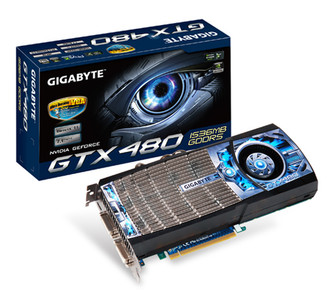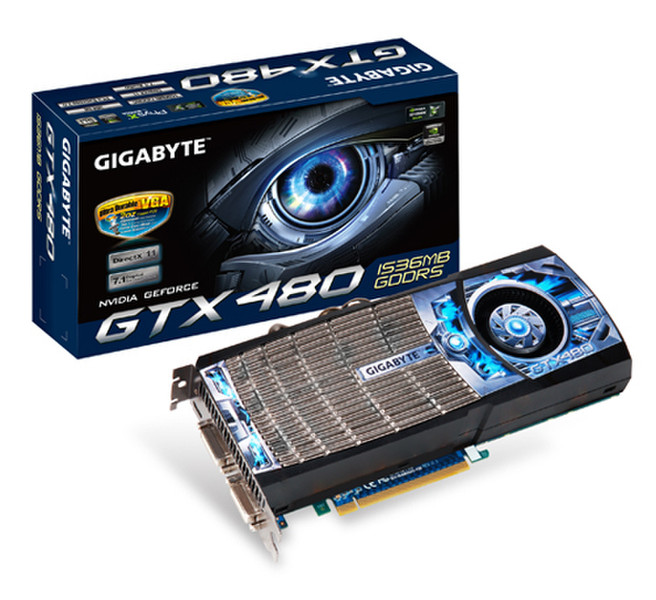目錄的
-
目錄的
- Antiquitäten & Kunst
- Auto & Motorrad: Fahrzeuge
- Baby
- Bücher
- Camping & Outdoor
- Feinschmecker
- Garten & Terrasse
- Haushalt & Wohnen
- Haustierbedarf
- Heimwerken & Garten
- IT和电子
- Kleidung & Accessoires
- Modellbau
- Musik
- PC- & Videospiele
- Sammeln & Seltenes
- Spielzeug
- TV, Video, DVD
- Telekommunikation
- Uhren & Schmuck
- Wellness & Beauty
- fashion & lifestyle
- institutional food services equipment
- medical equipment, accessories & supplies
- 个人护理
- 休闲爱好
- 办公设备,用品和配件
- 商业与工业
- 家居,建筑,装修
- 家用电器
- 摩托车及配件
- 武器和弹药
- 照相机
- 花园和庭院
- 运动,娱乐及休闲
- 食物
- 高保真音響
Filters
Search
Gigabyte GV-N480UD-15I GeForce GTX 480 1.5GB GDDR5 graphics card
凡购买和价格 (Advertising *)
顶部
技术特点
顶部
处理器
| 处理器频率 | 700 MHz |
|---|---|
| CUDA | Y |
| 着色器时钟 | 1401 MHz |
内存参数
| 图形适配器内存类型 | GDDR5 |
|---|---|
| 数据宽度 | 384 bit |
| 内存时钟速度 | 3696 MHz |
| 独立显卡适配器內存 | 1.5 GB |
性能
| DirectX版本 | 11 |
|---|---|
| OpenGL版本 | 3.2 |
| 最高着色模型版本 | 5.0 |
| PhysX | Y |
| 集成电视调谐器 | N |
| HDCP | Y |
其他功能
| HDMI | Y |
|---|---|
| Mac兼容性 | N |
端口 & 界面
| 接口类型 | PCI Express 2.0 |
|---|---|
| DVI-I接口数量 | 2 |
| VGA(D-SUB)端口数量 | 1 |
设计
| 冷却方式 | Active |
|---|
另外
| 图形处理器 | GeForce GTX 480 |
|---|---|
| 双dvi(互应式数字视频) | N |
GeForce GTX 480, 1536MB GDDR5, 2xDVI-I, HDMI, HDCP
GIGABYTE Ultra Durable VGA Series
1. Powered by NVIDIA GeForce GTX 480 GPU
2. Supports PCI Express 2.0
3. Microsoft DirectX 11 and OpenGL 3.2 support
4. Integrated with industry's best 1536 MB GDDR5 memory and 384-bit memory interface
5. Supports NVIDIA PureVideo® HD technology
6. Features Dual link DVI-I*2 / mini HDMI with HDCP protection
RoHS Compliant
As a citizen of the global village, GIGABYTE exert ourselves to be a pioneer in environment care. Give the whole of Earth a promise that our products do not contain any of the restricted substances in concentrations and applications banned by the RoHS Directive, and are capable of being worked on at the higher temperatures required for lead free solder. One Earth and GIGABYTE Cares!
Shader Model 5.0
Shader Model 5.0 adds support for indexed temporaries which can be quite useful for certain tasks.Regular direct temporary access is preferable is most cases. One reason is that indexed temporaries are hard to optimize. The shader optimizer may not be able to identify optimizations across indexed accesses that could otherwise have been detected. Furthermore, indexed temporaries tend to increase register pressure a lot. An ordinary shader that contains for instance a few dozen variables will seldom consume a few dozen temporaries in the end but is likely to be optimized down to a handful depending on what the shader does. This is because the shader optimizer can easily track all variables and reuse registers. This is typically not possible for indexed temporaries, thus the register pressure of the shader may increase dramatically. This could be detrimental to performance as it reduces the hardware’s ability to hide latencies.
PCI-E 2.0
PCI Express 2.0 –Now you are ready for the most demanding graphics applications thanks to PCI Express 2.0 support, which allows up to twice the throughput of current PCI Express cards. Doubles the bus standard's bandwidth from 2.5 Gbit/s (PCIe 1.1) to 5 Gbit/sec.
HDCP Support
High-Bandwidth Digital Content Protection (HDCP) is a form of copy protection technology designed to prevent transmission of non-encrypted high-definition content as it travels across DVI or HDMI digital connections.
Microsoft Window7
Microsoft Windows 7 is the next generation operating system that will mark a dramatic improvement in the way the OS takes advantage of the graphics processing unit (GPU) to provide a more compelling user experience. By taking advangate of the GPU for both graphics and computing, Windows 7 will not only make todays's PCs more visual and more interactive but also ensure that they have the speed and responsiveness customers want
HDMI Ready
High Definition Multimedia Interface (HDMI) is a new interface standard for consumer electronics devices that combines HDCP-protected digital video and audio into a single, consumer-friendly connector.
PureVideo HD
Available on HD DVDs and Blu-ray discs, high-definition movies are bringing an exciting new video experience to PC users. NVIDIA® PureVideo™ HD technology lets you enjoy cinematic-quality HD DVD and Blu-ray movies with low CPU utilization and power consumption, allowing higher quality movie playback and picture clarity.PureVideo HD technology provides a combination of powerful hardware acceleration, content security, and integration with movie players, plus all the features found in PureVideo.
CUDA Technology
NVIDIA® CUDA™ technology unlocks the power of the hundreds of cores in your NVIDIA® GeForce® graphics processor (GPU) to accelerate some of the most performance hungry computing applications. The CUDA™ technology already adopted by thousands of programers to speed up those performance hungry computing applications.
Windows Vista
NVIDIA's fourth-gereration GPU architecture built for Windows Vista gives users the best possible experience with the Windows Aero 3D graphical user interface.
Microsoft Direct 11
World's first DirectX 11 GPU with full Shader Model 4.0 support delivers unparalleled levels of graphics realims and film-quality effects.
40nm Technology
Faster clocks, double the transistor density of earlier 40 nm technology. 40nm technology helped make GTX 480 series products the most advanced GPUs ever highest clocks speeds, incredible feature integration, full performance and precision all the time, and ability to take advantage of future, higher-speed memories.
SLI Technology
Delivers up to 2X the performance of a single GPU configuration for unparalleled gaming experiences by allowing two graphics cards to run in parallel. The must-have feature for performance PCI Express graphics, SLI dramatically scales performance on 60 top PC games.
PhysX Technology
NVIDIA PhysX is the next big thing in gaming!Delivering physics in games is no easy task. It's an extremely compute-intensive environment based on a unique set of physics algorithms that require tremendous amounts of simultaneous mathematical and logical calculations. The best way to get real-time physics, such as explosions that cause dust and debris, characters with life-like motion or cloth that drapes and tears naturally is with an NVIDIA®PhysX™-ready GeForce® processor. PhysX software is widely adopted by over 150 games, is used by more than 10,000 registered users and is supported on Sony Playstation 3, Microsoft Xbox 360, Nintendo Wii and PC. PhysX™ technology will take gaming to a whole new level.
OpenGL 3.2 Optimizations
Ensure top-notch compatibility and performance for all OpenGL 3.2 application.
1. Powered by NVIDIA GeForce GTX 480 GPU
2. Supports PCI Express 2.0
3. Microsoft DirectX 11 and OpenGL 3.2 support
4. Integrated with industry's best 1536 MB GDDR5 memory and 384-bit memory interface
5. Supports NVIDIA PureVideo® HD technology
6. Features Dual link DVI-I*2 / mini HDMI with HDCP protection
RoHS Compliant
As a citizen of the global village, GIGABYTE exert ourselves to be a pioneer in environment care. Give the whole of Earth a promise that our products do not contain any of the restricted substances in concentrations and applications banned by the RoHS Directive, and are capable of being worked on at the higher temperatures required for lead free solder. One Earth and GIGABYTE Cares!
Shader Model 5.0
Shader Model 5.0 adds support for indexed temporaries which can be quite useful for certain tasks.Regular direct temporary access is preferable is most cases. One reason is that indexed temporaries are hard to optimize. The shader optimizer may not be able to identify optimizations across indexed accesses that could otherwise have been detected. Furthermore, indexed temporaries tend to increase register pressure a lot. An ordinary shader that contains for instance a few dozen variables will seldom consume a few dozen temporaries in the end but is likely to be optimized down to a handful depending on what the shader does. This is because the shader optimizer can easily track all variables and reuse registers. This is typically not possible for indexed temporaries, thus the register pressure of the shader may increase dramatically. This could be detrimental to performance as it reduces the hardware’s ability to hide latencies.
PCI-E 2.0
PCI Express 2.0 –Now you are ready for the most demanding graphics applications thanks to PCI Express 2.0 support, which allows up to twice the throughput of current PCI Express cards. Doubles the bus standard's bandwidth from 2.5 Gbit/s (PCIe 1.1) to 5 Gbit/sec.
HDCP Support
High-Bandwidth Digital Content Protection (HDCP) is a form of copy protection technology designed to prevent transmission of non-encrypted high-definition content as it travels across DVI or HDMI digital connections.
Microsoft Window7
Microsoft Windows 7 is the next generation operating system that will mark a dramatic improvement in the way the OS takes advantage of the graphics processing unit (GPU) to provide a more compelling user experience. By taking advangate of the GPU for both graphics and computing, Windows 7 will not only make todays's PCs more visual and more interactive but also ensure that they have the speed and responsiveness customers want
HDMI Ready
High Definition Multimedia Interface (HDMI) is a new interface standard for consumer electronics devices that combines HDCP-protected digital video and audio into a single, consumer-friendly connector.
PureVideo HD
Available on HD DVDs and Blu-ray discs, high-definition movies are bringing an exciting new video experience to PC users. NVIDIA® PureVideo™ HD technology lets you enjoy cinematic-quality HD DVD and Blu-ray movies with low CPU utilization and power consumption, allowing higher quality movie playback and picture clarity.PureVideo HD technology provides a combination of powerful hardware acceleration, content security, and integration with movie players, plus all the features found in PureVideo.
CUDA Technology
NVIDIA® CUDA™ technology unlocks the power of the hundreds of cores in your NVIDIA® GeForce® graphics processor (GPU) to accelerate some of the most performance hungry computing applications. The CUDA™ technology already adopted by thousands of programers to speed up those performance hungry computing applications.
Windows Vista
NVIDIA's fourth-gereration GPU architecture built for Windows Vista gives users the best possible experience with the Windows Aero 3D graphical user interface.
Microsoft Direct 11
World's first DirectX 11 GPU with full Shader Model 4.0 support delivers unparalleled levels of graphics realims and film-quality effects.
40nm Technology
Faster clocks, double the transistor density of earlier 40 nm technology. 40nm technology helped make GTX 480 series products the most advanced GPUs ever highest clocks speeds, incredible feature integration, full performance and precision all the time, and ability to take advantage of future, higher-speed memories.
SLI Technology
Delivers up to 2X the performance of a single GPU configuration for unparalleled gaming experiences by allowing two graphics cards to run in parallel. The must-have feature for performance PCI Express graphics, SLI dramatically scales performance on 60 top PC games.
PhysX Technology
NVIDIA PhysX is the next big thing in gaming!Delivering physics in games is no easy task. It's an extremely compute-intensive environment based on a unique set of physics algorithms that require tremendous amounts of simultaneous mathematical and logical calculations. The best way to get real-time physics, such as explosions that cause dust and debris, characters with life-like motion or cloth that drapes and tears naturally is with an NVIDIA®PhysX™-ready GeForce® processor. PhysX software is widely adopted by over 150 games, is used by more than 10,000 registered users and is supported on Sony Playstation 3, Microsoft Xbox 360, Nintendo Wii and PC. PhysX™ technology will take gaming to a whole new level.
OpenGL 3.2 Optimizations
Ensure top-notch compatibility and performance for all OpenGL 3.2 application.
-
支付方式
我们接受:











